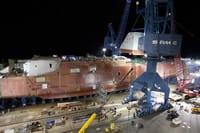
The Navy awarded General Dynamics [GD] a contract Friday to build a steel deckhouse for the third Zumwalt- class (DDG-1000) destroyer, effectively dropping plans to proceed with the composite structures that were built by Huntington Ingalls Industries [HII] for the first two ships in the class. Costs increases on the composite deckhouses prompted the Navy earlier this year to announce it was considering moving to a steel deckhouse for the third ship. The service solicited bids from shipbuilders, even as…












